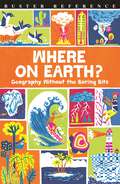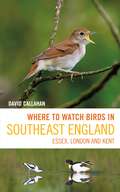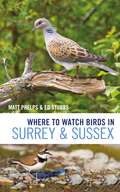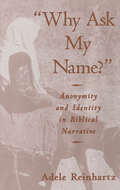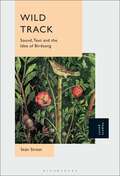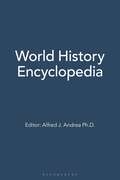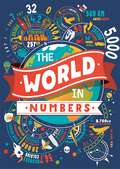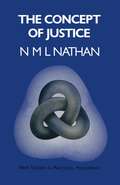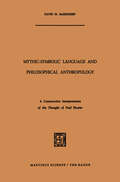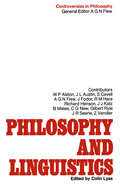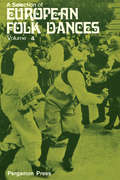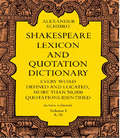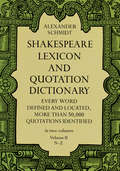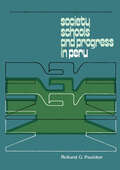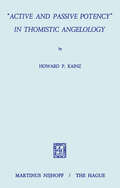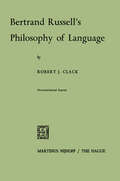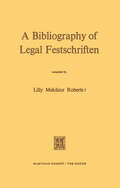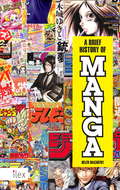- Table View
- List View
Where On Earth?: Geography Without the Boring Bits
by James DoyleWhere on Earth? is jam-packed with all of geography's greatest hits, with all the boring bits taken out. From how to make a raindrops to cool ways to remember the world's wonderful waterfalls, longest rivers and most desolate deserts - plus all the countries and continents in which these fantastic features are found. The perfect learning companion to help all school children get to grips with discovering the world around them.
Where to Watch Birds in Southeast England: Essex, London and Kent (Where to Watch Birds)
by David CallahanThe definitive site guide to a surprisingly bird-rich corner of England – Kent, Essex and the Greater London area.From the deep forests of Kent to the low-lying mudflats, beaches and saltmarshes of the Greater Thames Estuary, this ecologically rich area of England attracts vast numbers of wildfowl and waders. The region boasts many internationally and nationally important reserves including Rainham Marshes and Cliffe Pools, while Dungeness in Kent is one of Britain's best known birding hotspots for vagrant species such as Penduline Tit and Kentish Plover. London itself contains numerous birdwatching sites including Barnes and Woodberry Wetlands, along with some of the best spots in Britain for scarcities such as Lesser Spotted Woodpecker and Black Redstart. From Marsh Harrier and Firecrest to Curlew and Lapwing, there is plenty for birdwatchers to enjoy while exploring the parks, wetlands, woodlands and coast of southeast England. Written by life-long birdwatcher David Callahan, this is the definitive guide to the birding highlights of the region. It contains a comprehensive review of all the major sites and many lesser-known ones, with maps, notes on access, and information on target species and when to visit. Where to Watch Birds in Southeast England is indispensable for any birder exploring the region, or anyone in London wanting to head out to the countryside and enjoy a slice of our rich avian heritage.
Where to Watch Birds in Surrey and Sussex (Where to Watch Birds)
by Matthew Phelps Ed StubbsThis site guide covers the counties of East Sussex, West Sussex and Surrey, including sites in southwest Greater London. From the heaths of Surrey to the chalky grassland of the North and South Downs, the great forests of the Weald and the headlands, shingle beaches and river valleys of England's south coast, these three counties are a bird-rich part of the country, with perhaps the most diverse range of habitats in the country, and all within easy distance of London, the southwest part of which contains birding sites such as Barnes wetland centre.This new book by Matthew Phelps and Ed Stubbs is the definitive guide to the birding highlights of the region. It contains a comprehensive review of all the major sites, and many lesser-known ones, with maps, notes on access, and information on target species and when to visit. Where to Watch Birds in Surrey and Sussex is indispensable for any birder heading to this bird-rich region, or anyone in London who wants to head south to enjoy some of the best birding England can offer.
Why Ask My Name?: Anonymity And Identity In Biblical Narrative
by Adele ReinhartzUnnamed characters--such as Lot's wife, Jephthah's daughter, Pharaoh's baker, and the witch of Endor--are ubiquitous in the Hebrew Bible and appear in a wide variety of roles. Adele Reinhartz here seeks to answer two principal questions: first, is there a "poetics of anonymity," and if so, what are its contours? Second, how does anonymity affect the readers' response to and construction of unnamed biblical characters? The author is especially interested in issues related to gender and class, seeking to determine whether anonymity is more prominent among mothers, wives, daughters, and servants than among fathers, husbands, sons and kings and whether the anonymity of female characters functions differently from that of male characters.
Wild Track: Sound, Text and the Idea of Birdsong
by Seán StreetWild Track is an exploration of birdsong and the ways in which that sound was conveyed, described and responded to through text, prior to the advent of recording and broadcast technologies in the late 19th and early 20th centuries. Street links sound aesthetics, radio, natural history, and literature to explore how the brain and imagination translate sonic codes as well as the nature of the silent sound we "hear" when we read a text. This creates an awareness of sound through the tuned attention of the senses, learning from sound texts of the natural world that sought – and seek – to convey the intensity of the sonic moment and fleeting experience. To absorb these lessons is to enable a more highly interactive relationship with sound and listening, and to interpret the subtleties of audio as a means of expression and translation of the living world.
The Wisdom of Birds: Essential Life Lessons for Positivity and Grace
by Alison DaviesThis beautifully illustrated book shares the infinite wisdom of birds, providing inspiration from these small but mighty creatures on how to live bravely and care for the things we love.Taking sixty of the world’s most amazing birds beautifully illustrated by Victorian artist and ornithologist John Audubon, including the proud belted kingfisher, the delicate red throated loon, the elegant snowy egret and the laidback double crested cormorant, this book will share the unique characteristics and strengths that allow these birds to thrive, inspiring us to build with care and spread our wings.
World History Encyclopedia [21 volumes]: [21 volumes]
An unprecedented undertaking by academics reflecting an extraordinary vision of world history, this landmark multivolume encyclopedia focuses on specific themes of human development across cultures era by era, providing the most in-depth, expansive presentation available of the development of humanity from a global perspective. Well-known and widely respected historians worked together to create and guide the project in order to offer the most up-to-date visions available.A monumental undertaking. A stunning academic achievement. ABC-CLIO's World History Encyclopedia is the first comprehensive work to take a large-scale thematic look at the human species worldwide. Comprised of 21 volumes covering 9 eras, an introductory volume, and an index, it charts the extraordinary journey of humankind, revealing crucial connections among civilizations in different regions through the ages.Within each era, the encyclopedia highlights pivotal interactions and exchanges among cultures within eight broad thematic categories: population and environment, society and culture, migration and travel, politics and statecraft, economics and trade, conflict and cooperation, thought and religion, science and technology. Aligned to national history standards and packed with images, primary resources, current citations, and extensive teaching and learning support, the World History Encyclopedia gives students, educators, researchers, and interested general readers a means of navigating the broad sweep of history unlike any ever published.
The World in Numbers
by Clive Gifford Marianne Taylor Steve MartinA quirky, full-colour illustrated book jam-packed with over 2,000 fascinating figures and facts, The World in Numbers lets figures do the talking.Each themed, colourful page is crammed with tonnes of fascinating number-led facts. Discover how fast a sneeze travels, how many Earths could fit inside the Sun, the size of a T-rex’s teeth and much, much more. From animals and adventures, to fashion, food, bugs and buildings — there’s something for everyone in this brilliant book. Featuring light-hearted illustrations by Andrew Pinder.
Doctoral Dissertations on South Asia, 1966–1970: An Annotated Bibliography Covering North America, Europe, and Australia (Michigan Papers On South And Southeast Asia)
by Frank J ShulmanThis volume gathers the harvest of recent doctoral dissertations on South Asia, principally from North America and Western Europe, but exclusive of theses from universities in South Asia itself. The yield—1305 dissertations based on research carried out during the early and middle nineteen-sixties and brought to completion between 1966 and 1970—is even greater than one would have guessed, eloquent testimony to the expansion of South Asian studies in the West over the last decade. Doctoral Dissertations on South Asia seeks to be a comprehensive compilation of recently completed theses dealing in whole or in part with the former civilizations and the contemporary affairs of Ceylon, India, Nepal and Pakistan. At the same time, this work provides striking testimony of the dynamic growth of Asian Studies outside the subcontinent and particularly in the United States, Great Britain, Germany and France, where most of the major centers of scholarship are presently found. It is an interdisciplinary work covering the natural sciences as well as the humanities and social sciences.
Human Hope and the Death Instinct: An Exploration of Psychoanalytical Theories of Human Nature and Their Implications for Culture and Education
by David HolbrookHuman Hope and the Death Instinct: An Exploration of Psychoanalytical Theories of Human Nature and their Implications for Culture and Education focuses on the study of human nature. The manuscript first offers information on psychology as a form of philosophical anthropology and reactions against the Freudian theory, including the origins of love and hate, death instinct, and metapsychology and negation. The book then discusses human nature and the development of object-relations psychology. Topics include the theories of W. R. D. Fairbairn on love and structure of personality; relationships of psychology, poetry, and science; Fairbairn’s analysis of the logic of hate; and Melanie Klein’s concept of phantasy and aggression. The text evaluates the relationships of identity and social theory, education, culture, and moral development, as well as amorality, progress, and democracy. The manuscript also discusses the connection of psychoanalysis and existentialism, including Jean-Paul Sartre’s concept of freedom and R. D. Laing’s position on existentialism. The book is a vital source of data for readers wanting to study human nature.
Mythic-Symbolic Language and Philosophical Anthropology: A Constructive Interpretation of the Thought of Paul Ricœur
by David M. RasmussenThis book will attempt to achieve a constructive and positive correla tion between mythic-symbolic language and philosophical anthropolo gy. It is intended as a reflection on the philosophical accomplishment of Paul Ricoeur. The term mythic-symbolic language in this context means the language of the multivalent symbol given in the myth with its psychological and poetic counterparts. The term symbol is not con ceived as an abstract sign as it is used in symbolic logic, but rather as a concrete phenomenon - religious, psychological, and poetic. The task inherent in this correlation is monumental when one considers the dual dilemma of problematic and possibility which is at its heart. The prob lematic arises out of the apparent difficulty presented by the so-called challenge of modernity which seems to require the elimination of my thic-symbolic language as an intelligible mode of communication. Mythic-symbolic language is sometimes eliminated because in a world molded by abstract conceptualizations of science, such a language is thought to be unintelligible. The claim is that its "primitive" explana tions have been transcended by our modernity. Others believe that the problem of mythic-symbolic language is the problem of the myth. If the mythic forms of language could be eliminated, the truth of such language could be preserved through its translation into an intelligible mode of discourse. The problematic is heightened further by the relation of consider ations of language to philosophical anthropology. Any consideration of language involves a related view of the nature of man.
A Selection of European Folk Dances: Volume 4
by Unknown AuthorA Selection of European Folk Dances, Volume 4 is part of a series of booklets giving the dance sequence and music for a selection of folk dances from various European countries outside the British Isles. Organized into 10 chapters, this book begins with a description of the various holds and basic steps of the dances. Subsequent chapters detail specific dances of various countries including France, Israel, Sweden, Switzerland, and Mexico. Regional variations in steps and music are often numerous and some dances are performed differently in almost every village. This book provides this variety, making this reference valuable to those interested in this performing art.
Shakespeare Lexicon and Quotation Dictionary: A Complete Dictionary Of All The English Words, Phrases, And Constructions In The Works Of The Poet (Third Edition)
by Alexander SchmidtIn more than 300 years of Shakespearean scholarship, only one book, the famous Shakespeare Lexicon and Quotation Dictionary, has investigated the meaning of every word that Shakespeare wrote. The lifetime work of Professor Alexander Schmidt of Königsberg, this book has long been the indispensable companion for every person seriously interested in Shakespeare, Renaissance poetry and prose of any sort, or English literature. It is really two important books in one. <p><p> Schmidt’s set contains every single word that Shakespeare used, not simply words that have changed their meaning since the seventeenth century, but every word in all the accepted plays and the poems. Covering both quartos and folios, it carefully distinguishes between shades of meaning for each word and provides exact definitions, plus governing phrases and locations, down to the numbered line of the Cambridge edition of Shakespeare. There is no other word dictionary comparable to this work. <p> Even more useful to the general reader, however, is the incredible wealth of exact quotations. Arranged under the words of the quotation itself (hence no need to consult confusing subject classifications) are more than 50,000 exact quotations. Each is precisely located, so that you can easily refer back to the plays or poems themselves, if you wish context.Other features helpful to the scholar are appendixes on basic grammatical observations, a glossary of provincialisms, a list of words and sentences taken from foreign languages, a list of words that form the latter part of word-combinations. This third edition features a supplement with new findings.
Shakespeare Lexicon and Quotation Dictionary (Third Edition)
by Alexander SchmidtIn more than 300 years of Shakespearean scholarship, only one book, the famous Shakespeare Lexicon and Quotation Dictionary, has investigated the meaning of every word that Shakespeare wrote. The lifetime work of Professor Alexander Schmidt of Königsberg, this book has long been the indispensable companion for every person seriously interested in Shakespeare, Renaissance poetry and prose of any sort, or English literature. It is really two important books in one. <p><p> Schmidt’s set contains every single word that Shakespeare used, not simply words that have changed their meaning since the seventeenth century, but every word in all the accepted plays and the poems. Covering both quartos and folios, it carefully distinguishes between shades of meaning for each word and provides exact definitions, plus governing phrases and locations, down to the numbered line of the Cambridge edition of Shakespeare. There is no other word dictionary comparable to this work. <p> Even more useful to the general reader, however, is the incredible wealth of exact quotations. Arranged under the words of the quotation itself (hence no need to consult confusing subject classifications) are more than 50,000 exact quotations. Each is precisely located, so that you can easily refer back to the plays or poems themselves, if you wish context.Other features helpful to the scholar are appendixes on basic grammatical observations, a glossary of provincialisms, a list of words and sentences taken from foreign languages, a list of words that form the latter part of word-combinations. This third edition features a supplement with new findings.
Society, Schools and Progress in Peru: The Commonwealth and International Library: Education and Educational Research
by Rolland G PaulstonSociety, Schools, and Progress in Peru presents a descriptive analysis of the Peruvian educational system, with particular emphasis on socio-cultural changes that have transpired.The publication first elaborates on cultural and educational traditions, emergence of public schooling, and the social, economic, and political context of education. Concerns cover political organization, economic setting, educational consequences of socio-cultural stratification, social organization, race and culture, US education missions, Indian and Spanish heritage, and colonial and Republican education. The text then takes a look at educational objectives and administration, formal school programs, nonformal education, and preparation of teachers. Topics include teacher supply and demand, teacher-preparation programs, reform efforts, education in the military, education and industry, first-level educational programs, and administrative organization. The text ponders on education, revolution, and nation-building, higher education, and teacher professionalization programs. The book is a valuable source of data for historians and educators interested in the development of the educational system in Peru.
Society, Schools and Progress in the West Indies: Education and Educational Research
by John J. FigueroaSociety, Schools and Progress in the West Indies is one of a mutually supporting series in this field of interest in a number of significant countries or region. This book focuses on West Indies, aiming to provide important information about education and society, to raise certain questions which need to be carefully considered if education is to lead to real human development, and to provide informed opinion on a variety of subjects affecting society, schools, and progress . Organized into seven chapters, this book begins with an historical survey of education in the West Indies. It then talks about the socio-economic complex, and the school and general education arrangements in the area. The prevalent aims and assumptions in this field are also shown. Subsequent chapters explore the important matter of priorities in education in the West Indies, and define the concept of ""education for development"". This book will be very helpful for students of sociology, government and politics, as well as education.
Wittgensteins Philosophische Grammatik: Entstehung und Perspektiven der Strategie eines radikalen Aufklärers
by M. Lang“Active and Passive Potency” in Thomistic Angelology
by H.P. KainzA. "SEPARATE SUBSTANCES" AND lOR" ANGELS"? It is interesting to note that, in an expressly theological treatise such as the Summa theologiae, St. Thomas generally uses the term "angel", in preference to "separate substance"; while in works with a less explicit theological intent - e. g. the Summa contra gentiles and the De substantiis separatis 1 - he generally prefers the term "separate substance". But at any rate there is little doubt that the two terms, "separate sub stance" and "angel" have a certain interchangeability and equivalence in the works of St. Thomas. In other words, "the separate substance" is equivalent to "the angel, insofar as its existence and attributes are knowable through human reason alone". And this has led Karl Barth 2 to charge that St. Thomas' angelology is primarily a philosophical presenta tion, with little relevance to theology. 1 We might say that these works are "philosophical" insofar as arguments from reason are emphasized in them, rather than arguments from revelation or faith. However, as Lescoe points out (in the Introduction to his edition of the De substantUs separatis, p. 8), the treatise on separate substances leads up to theological subject-matter in Ch. 's XVII ff- namely, an exposition of Catholic teaching as found in Sacred Scripture, the Fathers, and especially Dionysius. And Chenu maintains that the Summa contra gentiles is basically a theological work, because it not only leads up to theological subject-matter in Bk.
Bertrand Russell's Philosophy of Language
by R. ClackRUSSELL AND THE LINGUISTIC PHILOSOPHY It is generally acknowledged that Bertrand Russell played a vital role in the so-called "revolution" that has taken place in twentieth century Anglo-American philosophy, the revolution that has led many philo sophers virtually to equate philosophy with some variety - or varieties - of linguistic analysis. His contributions to this revolution were two fold: (I) together with G. E. Moore he led the successful revolt against the neo-Hegelianism of Idealists such as Bradley and McTaggert; (2) again with Moore he provided much of the impetus for a somewhat revolutionary way of doing philosophy. (I) and (2) are, of course, close ly related, since the new way of philosophizing could be said to consti tute, in large part, the revolt against Idealism. Be this as it may, how ever, the important fact for present consideration is that Russell was a major influence in turning Anglo-American philosophy in the direction it has subsequently taken - toward what may be termed, quite general ly, the "linguistic philosophy. " Unfortunately, though his importance as a precursor of the linguistic philosophy is well-known, the precise sense in which Russell himself can be considered a "philosopher of language" has not, to the present time, been sufficiently clarified. Useful beginnings have been made toward an investigation of this question, but they have been, withal, only begin nings, and nothing like an adequate picture of Russell's overall philoso phy of language is presently available.
A Bibliography of Legal Festschriften
by L. M. RobertsThe idea of compiling a bibliography of legal Festschriften originated with Lilly Roberts, and represented the most important creative side of her life during the last ten years of her association with the Universi ty of Michigan Law Library. The project received advice and counsel from the Foreign Law Com mittee of the American Association of Law Libraries. The final publi cation was made possible by an allocation from the grant made to the University of Michigan Law School by the Ford Foundation for re search in International and Comparative Law. Beverley J. Pooley Professor of Law Director of the Law Library University of Michigan PREFACE The present bibliography is international in scope; it covers Fest schriften published in many countries. It includes Festschriften from 1868 (date of the earliest legal Festschrift found) through December, 1968. A bibliography of all legal Festschriften, to be complete, could only be achieved through the cooperative effort of an international group of experts. The present bibliography is based on notes gathered by the compiler over a period of years from material available at the University of Michigan Law Library. It is therefore, inevitably, incom plete and occasionally inaccurate and must be considered as a tentative list, subject to implementation and correction at other legal centers. It was felt, however, that its publication might be of some use, since not enough bibliographical information about this important and steadily growing type of legal literature exists.
A Brief History of Manga: The Essential Pocket Guide to the Japanese Pop Culture Phenomenon
by Helen McCarthyManga is more than a genre in the comics field: it is a vital creative medium in its own right, with hundreds of millions of readers worldwide, a host of graphic styles, and a rich history now spanning seven decades.Now for the first time, that history is told by an award-winning expert in the field. Covering topics from Akira to Mazinger Z, this book is fully illustrated throughout, and photos of key creators accompany accessible sidebars and timelines.Answering the key questions of any fan where did my favourite manga come from, and what should I read next? this book will open doors to neophytes and experts alike.
The Economics of Urban Areas (Urban and Regional Planning Series #Volume 3)
by B. GoodallUrban and Regional Planning Series, Volume 3: The Economics of Urban Areas focuses on the importance of economic considerations in the functioning of urban systems. The publication first elaborates on the economic dimension of urbanization, nature of economic analysis, urban policy and planning implications, and use of economic models. The text then examines the economic basis of urban areas, urban real property market, and urban land-use patterns. Discussions focus on differences in land-use patterns between urban areas, generalized pattern of urban land use, determination of real property prices, nature of urban land and property values, and the nature and function of the urban real property market. The book takes a look at urban location decisions, urban growth, and level of urban economic activity. Topics include urban growth versus fluctuations in urban economic activity, planning and redevelopment, economics of redevelopment, factor influencing expansion patterns and choice of residential location, and determination of urban land-use patterns. The manuscript also examines the size and spacing of urban areas and urban economic growth. The publication is a valuable source of data for researchers interested in the economics of urban areas.
